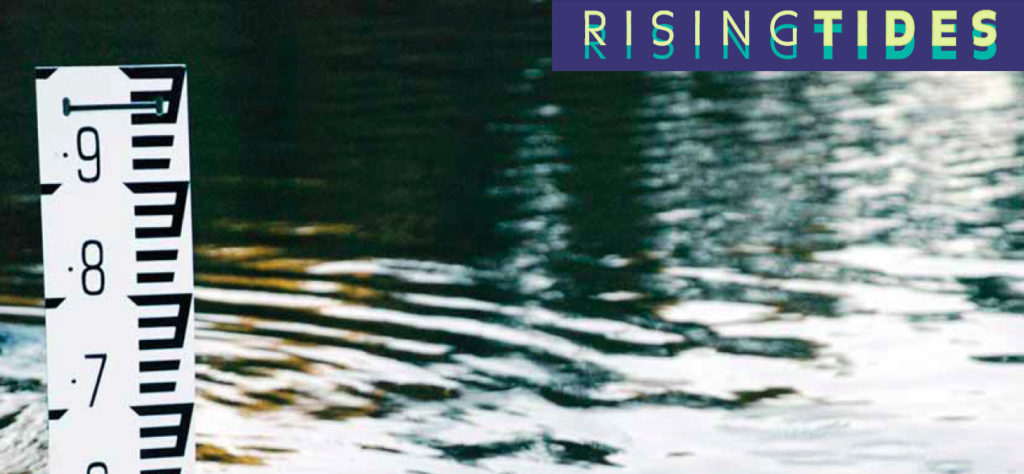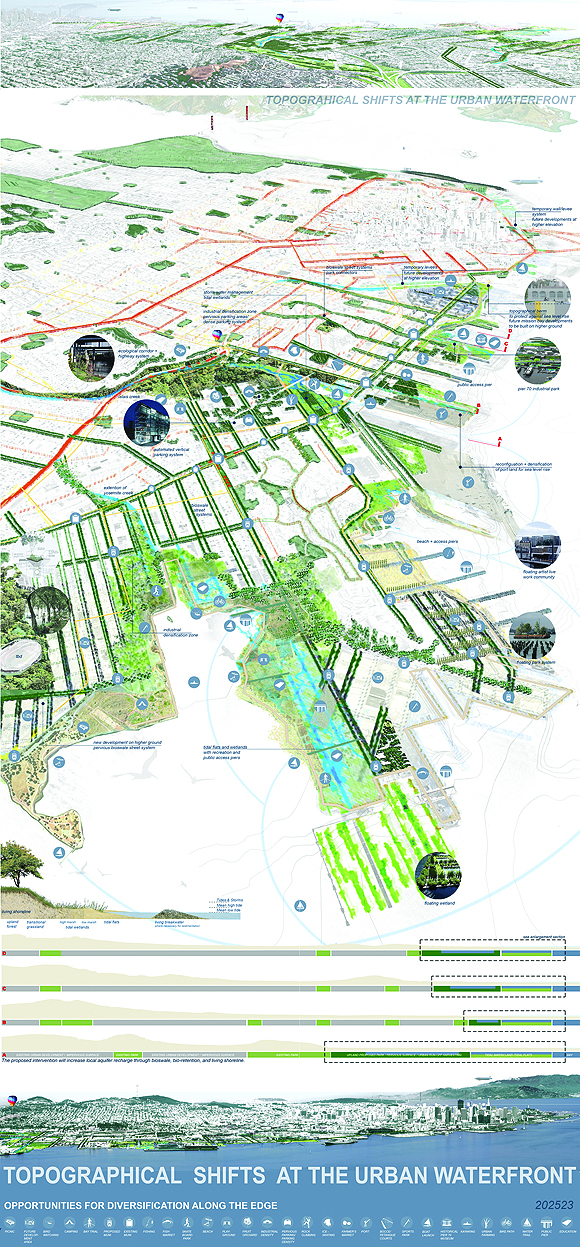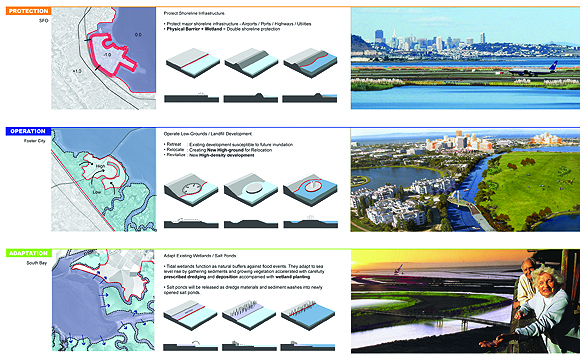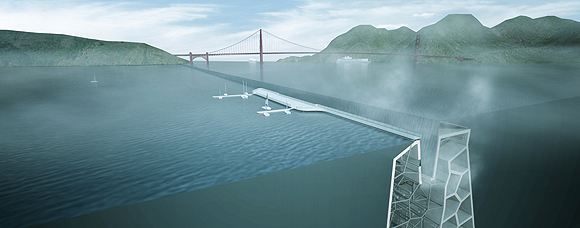BCDC, the San Francisco based Bay Conservation and Development Commission, is a state agency created by the California legislature in 1965. Their web site (www.bcdc.ca.gov) has all the exciting content of a typical state bureaucracy. Headings include “Dredging and Sediment Management,” “Permits,” “Enforcement,” “Regulations,” and “Policies.” How is it, then, that BCDC has sponsored an international ideas competition seeking strategies for dealing with rising sea level? And in the middle of a budget crisis?
The answer, of course, is that even bureaucratic state agencies are staffed by individuals—in this case remarkable individuals. Executive Director Will Travis and his team, led by Brad McCrea, decided that they were in a unique position to pose important questions and share the responses with others around the country and the world. With a federal (not state) grant from the National Oceanic and Atmospheric Administration, they hired a competition advisor (the author) to help them launch and run “Rising Tides.”
The first step was to forge key alliances, the most important of which was with the AIA San Francisco chapter, to handle registration and payment. Graphic designer Kelly Macy (www.kellymacy.com) built a beautifully simple site that wasn’t suffocated by the state’s web site standards. Although the focus was San Francisco Bay, rising sea level is an issue for coastal environments worldwide, so the jury would need to be a blend of local and global expertise. Three Americans—architect and writer Michael Sorkin; Bay Area landscape architect Walter Hood; and New Orleans based estuary expert Denise Reed—were complemented by two experts from abroad, Dutch coastal geomorphologist Marcel Stive from Delft and cultural landscape journalist Tracy Metz from Amsterdam. Over 135 entries were received; there were six winning ideas and seven honorable mentions.
The six winners suggest three distinct approaches. Two are about communicating the immensity and physical complexity of the challenges to come. RAYdike uses laser beams to mark future sea level at its projected height at full scale all around the Bay, while The Hundred Year Plan proposes a toolkit for the larger water issues tied to rising sea level. Another two suggest incremental approaches. Topological Shifts allows the Bay to infiltrate the urban fabric over time, creating a new kind of green city condition. Evolutionary Recovery prepares low-lying communities to abandon unsustainable positions and move to higher ground. The last two winners push the boundaries of hybrid solutions that blend ecology and technology. BayARC suggests an operable tidal curtain right at the Golden Gate, while Folding Water regulates water levels at points around the Bay where an intervention could prevent flooding.
Topological Shifts
Wright Huachi Yang and Lee Stickles, SWA Group
TEAM CREDITS:
Wright Huaiche Yang + J. Lee Stickles
San Francisco, California
Special Thanks to: SWA Group
In San Francisco, . . . the area most affected by sea level rise is the industrial eastern waterfront . . . . If sea level rise were to take a natural course over the next 100 years, much of this edge would be at the elevation of tidal wetlands. However, sea level rise will constantly be in flux as it adjusts and shifts over time, and any intervention should be capable to alter with it. The complicated edge of the industrial landscape of San Francisco calls for various interventions that recognize the need for change over time and adjustment for the future. The idea of this proposal is to strengthen and extend upon already proposed development ideas to reach a realistic proposal for sea level rise. For our generation, we must decide which areas are crucial to protect and which areas can take a natural course of change, and shift and adjust as we negotiate with the sea. The intention of this proposal is to set up a framework and strategy for future generations, one that is conscious of a larger context [and] that is adaptable for change over time, as the next generation will likely view this edge differently.
The Hundred Year Plan
Derek Hoeferlin
TEAM CREDITS:
Derek James Hoeferlin, Architect (co-lead, design + production)
Ian Caine (co-lead, design + production)
Michael Heller (research assistant)
St. Louis, Missouri
It is naïve to focus on rising tides as the most significant outcome of climate change. Rising tides are merely one symptom of a more daunting water crisis. The threat of rising tides can provide a catalyst which leads us to comprehensively re-balance the water system in California and beyond. Our 100 Year Plan is political first and foremost. It advocates for an ambitious policy-based Toolkit that trades the “watershed hopping” method of massive water transport (which is energy intensive and environmentally destructive) for a more localized approach. We propose fresh water via sustainable desalination and water recycling programs along with tidal marsh regeneration, powered and protected by rising tides over the course of the next 100 years.
RAYdike
Thom Faulders
TEAM CREDITS:
Faulders Studio, Berkeley (Thom Faulders, Jang Hyung Lee, Sean McGuire, Devin Rutz)
Night Photography: Jeremy Chang
RAYdike is a temporary laser light marker system that accurately maps a hypothetical barrier network required to protect Bay Area cities from rising water caused by climate change.
By mapping directly upon the bay how a large, standard earthen dike system lining the coast would appear, complete with accurate elevation heights and geographic locations, RAYdike is a real-time knowledge and awareness system. Additionally, once deployed, its presence could begin to stem the flow of new urban development into affected low-lying areas and would initiate the process for tidal zone land reclamation.
Evolutionary Recovery
Yumi Lee
TEAM CREDITS:
Yumi Lee + Yeon Tae Kim, LANDplus Design
Special Thanks to: EPRI, Giyoung Park / Architect
San Francisco Bay is one living organism. It breathes, circulates and transforms over time. During the past century, San Francisco Bay has suffered from a tremendous loss of its body—more than 40% due to the heavy shoreline development.
The global warming phenomenon calls for both challenges and opportunities for San Francisco Bay. If continuous climate change is anticipated, the sea level at the Bay is projected to be 4.5 feet higher in 2100. This will result in massive inundation of the San Francisco Bay shoreline. Ironically, the sea level rise will bring back the Bay to the size that it was a century ago.
Evolutionary Recovery begins. There is no one magical solution for this recovery process. Some wounds have stitches to heal, while some need simple clean-ups. Others require major surgery. This design proposal defines the Bay’s Evolutionary Recovery process and identifies three recovery zones: Protection. Operation. Adaptation
Folding Water
Kuth Ranieri Architects
TEAM CREDITS:
Kuth Ranieri Architects, San Francisco, California (Byron Kuth, FAIA, LEED AP, Elizabeth Ranieri, AIA, LEED AP, Steve Const, LEED AP, Gretta Tritch, Matt Hutchinson)
Mark Stacy, Professor in Civil and Environmental Engineering, UC Berkeley
Folding Water is a levee mitigation system that maintains water elevations for existing shorelines that are susceptible to flooding and manages rising ocean waters through the design of a bifurcated water surface strategy. This stealth infrastructural system manages water—and is made of water—artistically preserving the interface of culture and ecology by reforming the bay surface. Without a divisive barrier, it extends the natural ecology of the bay and maintains vistas and visual connections that characterize its unique estuarine beauty.
Tidal cycles are artificially managed through a perforated wall of pump “ventilators,” located at key sections along its full height, to allow the transport of the entire water column between the shoreline and ocean waters, creating Bay Avatars. By ventilating the regulated body of water, it recreates the ecological exchanges of sediment, salinity, and biota promoted by the tides . . . . [It] can be specifically/locally tuned to accommodate the variety of shoreline conditions of its estuary.
BayArc
SOM San Francisco
TEAM CREDITS:
SOM San Francisco (Craig Hartman, FAIA; Design Team: Mark Schwettmann, Leo Chow, Geoffrey Brunn, Alex Cruz, Ross Findly)
Structural Engineering Concept: SOM (Mark Sarkisian, Eric Long, David Shook)
Marine Engineering Concept: Moffatt & Nichol Marine
Engineering, Dilip Trivedi, Richard Dornhelm
Graphic Design: SOM (Lonny Israel, Alexander Ng)
. . . [T]he principle threat of flooding in the next century is not from the rise in the sea level itself, but from the increase in extremes during high tides, which create breaches of existing flood defenses for relatively brief periods.
The objective of the BayArc is to prevent the peak of extreme tide events while maintaining a natural tidal exchange between the ocean and the bay.
The BayArc consists of a submerged, cable-reinforced membrane anchored to the seabed that utilizes a bladder embedded in a tensile leading edge fastened to structural pylons at the water’s edge. When deployed, the BayArc floats to the surface and its tensile membrane creates a barrier stretching from the water’s edge to the sea floor. When it is not needed, the bladder is deflated, the BayArc sinks and rests on the sea floor.
When the peak tide is projected to rise above a threat level, the BayArc is deployed. It remains deployed only until the high-tide peak has passed, “shaving off” the peak into the bay . . . . [P]rojections for sea level rise by 2050 would require deployment for only a few hours per day and only a few times per year.
Author David Meckel, FAIA, is Director of Research & Planning for the California College of the Arts (CCA) in San Francisco.
Originally published 4th quarter 2009 in arcCA 09.4, “Infrastructure.”












